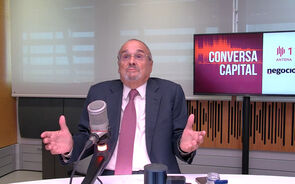Enganaran-me
8 mensagens
|Página 1 de 1
Uma outra opinião...
By Eric Wahlgren
Why Gold and Stocks Are Rising Togther
Although they usually move in opposite directions, this time around an odd confluence of factors is sparking both higher simultaneously
Markets are acting a bit whacky these days. One of the more unusual trends: Gold prices have been rising along with the stock market. Typically, the yellow metal is considered something of a sky-is-falling asset that investors buy when equities are tanking and everything else looks pretty grim. In the past, gold and stock prices have tended to move in opposite directions. Not this year. The Standard & Poor's 500-stock index has gained about 22% year-to-date, while gold stocks are up about 66%. On Nov. 19, the precious metal even broke $400 an ounce, a high not seen in seven years.
Advertisment
With gold, stocks, and even certain types of fixed-income investments all rallying at the same time, the current situation is a somewhat befuddling. "This is anything but a usual cycle," says A.C. Moore, chief investment strategist with Dunvegan Associates in Santa Barbara, Calif. "You can pretty much throw away the textbook on what has happened in the last few years."
HUGE LIQUIDITY PUSH. The good news for stock investors is that this time around, the past is not necessarily prologue. Even if gold climbs further, money flows to this traditional haven may not necessarily mean equities are bound to fall. "In this environment, [rising equity and gold prices] can coexist," says Michael Cuggino, portfolio manager of the Permanent Portfolio (PRPFX ), which keeps about 20% of its holdings in gold bars and coins.
Both have risen in part because gigantic economic stimulus was triggered by President George W. Bush's federal tax cuts and the Federal Reserve's interest rate reductions. They helped several different asset classes that tend to be inversely related. Stocks, bonds, and gold have been rising as investors sought places to put their money. "The liquidity push has been unprecedented," Moore says.
Another important thing to remember, Johnson says, is that gold's performance is a lot more dependent on stocks than the stock market's performance is on gold. If equity prices rise, it could lure investors out of the metal and into stocks. But a spike in gold prices is hardly going to prompt a huge number of investors to swap stocks for gold. Over the long term, the metal hasn't performed as well as equities. "The stock market is the independent variable, and gold prices are the dependent variable," says Mark Johnson, portfolio manager of the USAA Precious Metals & Minerals Fund (USAGF ).
FALLING DOLLAR POWER. Why the stock market has advanced this year is simple. After a three-year bear market, stocks were due for a nice rebound as corporate earnings, the main influence on equity prices, began to recover along with the U.S. economy. In the third quarter, profits increased a tidy 21.5%, with results in from all but 14 outfits in the S&P 500, according to Thomson/First Call.
The reasons behind gold's rise are a bit trickier. The main one is that the U.S. dollar is falling as the nation's trade and federal budget deficits widen. The more the dollar declines against other currencies, the more greenbacks one needs to buy an ounce of gold, as the metal typically holds its value. It's no coincidence that gold prices hit their seven-year high on Nov. 19, the same day the dollar fell to a record low against the euro.
"In the last few months, the dollar has been the primary driver of what's happened to the price of gold," says Johnson. Other factors in this year's run are persistent global instability and ongoing fears about a possible resurgence of inflation as the economy gains strength. Both can send investors running to what's perhaps the ultimate in hard assets.
INCIPIENT INFLATION? Still, higher gold prices could be a harbinger of at least two potentially damaging scenarios for stocks. In the first case, the greenback could continue to weaken. Such a trend could lead foreign investors to question the value of owning so many U.S. dollar-denominated assets -- including stocks -- that are declining in value.
"Over time, that could have an impact on foreigners holding U.S. securities and could cause them to sell," Sarat Sethi, a partner and portfolio manager at New York investment advisory firm Douglas C. Lane & Associates, recently told BusinessWeek Online (see BW Online, 11/21/03, "Rising on a Falling Dollar").
The other major concern is that a sustained gold rally could indicate incipient inflation. So far, on the consumer level it has been tame, with the consumer price index climbing at a subdued 2.3% seasonally adjusted annual rate for the first 10 months of 2003. But some signs indicate that it could creep higher.
NOT NECESSARILY BAD. For starters, the U.S. economy appears to be roaring back. It grew at a powerful 8.2% annual pace in the third quarter, though many economists doubt that macho rate is sustainable. Still, the Reuters-CRB index of 17 commodities shows futures prices are up 5.5% year-to-date, suggesting early signs of inflation, says Leo Larkin, Standard & Poor's diversified mining and metals analyst. "I doubt we'll have a replay of the '70s low-double-digit inflation," Larkin says. "But low-single-digit inflation is on the horizon."
Of course, the Fed could quickly step in and hike rates to fight any signs that inflation is picking up. As the chain-reaction thinking goes, steeper interest rates could jack up corporate and consumer borrowing costs, crimping spending and hurting companies, which in turn would dent the stock market. But with the federal funds rate at a superlow 1%, "we have a long way to go before any Federal Reserve rate hikes begin to curb economic growth," says John Lonski, chief economist with Moody's Investor Service in New York.
In fact, a little inflation might not be a bad thing, Lonski says. Higher prices could increase corporate profit margins, boosting corporate earnings, he says. "It's like blood pressure," Lonski says. "It can be too high and too low."
ROOM TO RUN. Most strategists believe that the outlook for stocks in the next few months is positive, despite these odd market trends. Moore argues that with one-year CDs yielding only 1%, equities look quite attractive. The dividend yield on the S&P 500 is 1.7%, and the index' earnings yield (earnings divided by price) is 3.3%.
"Stocks are relatively undervalued to fixed-income instruments, and the economic cycle is improving," Moore says. Indeed, barring a huge surge in inflation or a dramatic plunge in the dollar, the stock market will probably continue to do just fine.
Wahlgren covers financial markets for BusinessWeek Online in New York and writes for the Street Wise column
Edited by Beth Belton
Why Gold and Stocks Are Rising Togther
Although they usually move in opposite directions, this time around an odd confluence of factors is sparking both higher simultaneously
Markets are acting a bit whacky these days. One of the more unusual trends: Gold prices have been rising along with the stock market. Typically, the yellow metal is considered something of a sky-is-falling asset that investors buy when equities are tanking and everything else looks pretty grim. In the past, gold and stock prices have tended to move in opposite directions. Not this year. The Standard & Poor's 500-stock index has gained about 22% year-to-date, while gold stocks are up about 66%. On Nov. 19, the precious metal even broke $400 an ounce, a high not seen in seven years.
Advertisment
With gold, stocks, and even certain types of fixed-income investments all rallying at the same time, the current situation is a somewhat befuddling. "This is anything but a usual cycle," says A.C. Moore, chief investment strategist with Dunvegan Associates in Santa Barbara, Calif. "You can pretty much throw away the textbook on what has happened in the last few years."
HUGE LIQUIDITY PUSH. The good news for stock investors is that this time around, the past is not necessarily prologue. Even if gold climbs further, money flows to this traditional haven may not necessarily mean equities are bound to fall. "In this environment, [rising equity and gold prices] can coexist," says Michael Cuggino, portfolio manager of the Permanent Portfolio (PRPFX ), which keeps about 20% of its holdings in gold bars and coins.
Both have risen in part because gigantic economic stimulus was triggered by President George W. Bush's federal tax cuts and the Federal Reserve's interest rate reductions. They helped several different asset classes that tend to be inversely related. Stocks, bonds, and gold have been rising as investors sought places to put their money. "The liquidity push has been unprecedented," Moore says.
Another important thing to remember, Johnson says, is that gold's performance is a lot more dependent on stocks than the stock market's performance is on gold. If equity prices rise, it could lure investors out of the metal and into stocks. But a spike in gold prices is hardly going to prompt a huge number of investors to swap stocks for gold. Over the long term, the metal hasn't performed as well as equities. "The stock market is the independent variable, and gold prices are the dependent variable," says Mark Johnson, portfolio manager of the USAA Precious Metals & Minerals Fund (USAGF ).
FALLING DOLLAR POWER. Why the stock market has advanced this year is simple. After a three-year bear market, stocks were due for a nice rebound as corporate earnings, the main influence on equity prices, began to recover along with the U.S. economy. In the third quarter, profits increased a tidy 21.5%, with results in from all but 14 outfits in the S&P 500, according to Thomson/First Call.
The reasons behind gold's rise are a bit trickier. The main one is that the U.S. dollar is falling as the nation's trade and federal budget deficits widen. The more the dollar declines against other currencies, the more greenbacks one needs to buy an ounce of gold, as the metal typically holds its value. It's no coincidence that gold prices hit their seven-year high on Nov. 19, the same day the dollar fell to a record low against the euro.
"In the last few months, the dollar has been the primary driver of what's happened to the price of gold," says Johnson. Other factors in this year's run are persistent global instability and ongoing fears about a possible resurgence of inflation as the economy gains strength. Both can send investors running to what's perhaps the ultimate in hard assets.
INCIPIENT INFLATION? Still, higher gold prices could be a harbinger of at least two potentially damaging scenarios for stocks. In the first case, the greenback could continue to weaken. Such a trend could lead foreign investors to question the value of owning so many U.S. dollar-denominated assets -- including stocks -- that are declining in value.
"Over time, that could have an impact on foreigners holding U.S. securities and could cause them to sell," Sarat Sethi, a partner and portfolio manager at New York investment advisory firm Douglas C. Lane & Associates, recently told BusinessWeek Online (see BW Online, 11/21/03, "Rising on a Falling Dollar").
The other major concern is that a sustained gold rally could indicate incipient inflation. So far, on the consumer level it has been tame, with the consumer price index climbing at a subdued 2.3% seasonally adjusted annual rate for the first 10 months of 2003. But some signs indicate that it could creep higher.
NOT NECESSARILY BAD. For starters, the U.S. economy appears to be roaring back. It grew at a powerful 8.2% annual pace in the third quarter, though many economists doubt that macho rate is sustainable. Still, the Reuters-CRB index of 17 commodities shows futures prices are up 5.5% year-to-date, suggesting early signs of inflation, says Leo Larkin, Standard & Poor's diversified mining and metals analyst. "I doubt we'll have a replay of the '70s low-double-digit inflation," Larkin says. "But low-single-digit inflation is on the horizon."
Of course, the Fed could quickly step in and hike rates to fight any signs that inflation is picking up. As the chain-reaction thinking goes, steeper interest rates could jack up corporate and consumer borrowing costs, crimping spending and hurting companies, which in turn would dent the stock market. But with the federal funds rate at a superlow 1%, "we have a long way to go before any Federal Reserve rate hikes begin to curb economic growth," says John Lonski, chief economist with Moody's Investor Service in New York.
In fact, a little inflation might not be a bad thing, Lonski says. Higher prices could increase corporate profit margins, boosting corporate earnings, he says. "It's like blood pressure," Lonski says. "It can be too high and too low."
ROOM TO RUN. Most strategists believe that the outlook for stocks in the next few months is positive, despite these odd market trends. Moore argues that with one-year CDs yielding only 1%, equities look quite attractive. The dividend yield on the S&P 500 is 1.7%, and the index' earnings yield (earnings divided by price) is 3.3%.
"Stocks are relatively undervalued to fixed-income instruments, and the economic cycle is improving," Moore says. Indeed, barring a huge surge in inflation or a dramatic plunge in the dollar, the stock market will probably continue to do just fine.
Wahlgren covers financial markets for BusinessWeek Online in New York and writes for the Street Wise column
Edited by Beth Belton
- Mensagens: 197
- Registado: 10/11/2002 23:04
- Localização: Alentejo
-
Visitante
Re: Enganaran-me
cmafonso Escreveu:Anda um gajoa ouvir analistas a ler livros a estudar o que os mercados fizeram no passado e chega-se a conclusao que os metais preciosos e os mercados financeiros seguem caminhos opostos Alias um analista dizia todo entusiasmado em abril que os mercdos iam ter uma grande subida nos meses seguintes e acertou em cheio
mas dizia tambem que o ouro iria recuar para os 300 dolares so que aqui falhou redondamente
A leitura do fulano pareceu-me correcta tendo como base tudo aquilo que eu tinha estudado ate entao .So que neste momento estamos em maximos de muitos anos nos metais preciosos
e estamos nos maximos dos ultimos tempos nos mercados financeiros

Sera que alguem
consegue acrescentar algum dado que eu nao tenho ponderado para que se de esta incoerencia historica????
Permita-me a minha opinião..
O Terrorismo!!!
Foi um dos temos que opinei com frequência aqui no caldeirão no inicio deste ano Por absurdo que pareça, ainda hoje estou convencido, que num eventual grande atentado no futuro , as Bolsas subiriam com maior velocidade todavia Por outras palavras, os inimigos da civilização ocidental, teriam já á muito tempo acabado com a sociedade de consumo, se tivéssemos seguido o caminho do medo
O sistema defende-se obviamente...
R. Martins
Quem não conhece o «CALDEIRÃO» não conhece este mundo
- Mensagens: 1611
- Registado: 5/11/2002 9:23
Eu creio que historicamente os metais prciosos serviram de refugio as "intemperies" bursateis nao as acompanhavam nas subidas pelo menos e isso que dizem os livros 
Ja agora como e que se explica que os mercados europeus e americanos estejam a subir de maos dadas com a recente flutuaçao cambial ???????

abraço.
Ja agora como e que se explica que os mercados europeus e americanos estejam a subir de maos dadas com a recente flutuaçao cambial ???????
abraço.
- Mensagens: 544
- Registado: 6/12/2002 0:05
Já agora, deixa-me acrescentar que o Euro tb está em máximos...

FLOP - Fundamental Laws Of Profit
1. Mais vale perder um ganho que ganhar uma perda, a menos que se cumpra a Segunda Lei.
2. A expectativa de ganho deve superar a expectativa de perda, onde a expectativa mede a
__.amplitude média do ganho/perda contra a respectiva probabilidade.
3. A Primeira Lei não é mesmo necessária mas com Três Leis isto fica definitivamente mais giro.
metais preciosos
Eu não acho que os metais precisos oscilem na razão inversa dos títulos mas sim do dollar.
E isso é muito evidente no caso do ouro.
Se converteres a cotação do ouro de dollares para Francos Suiços a subida dele torna-se diminuta.
Ou mesmo para Euros...
JAS
E isso é muito evidente no caso do ouro.
Se converteres a cotação do ouro de dollares para Francos Suiços a subida dele torna-se diminuta.
Ou mesmo para Euros...
JAS
Enganaran-me
Anda um gajo  a ouvir analistas a ler livros a estudar o que os mercados fizeram no passado e chega-se a conclusao que os metais preciosos e os mercados financeiros seguem caminhos opostos Alias um analista dizia todo entusiasmado em abril que os mercdos iam ter uma grande subida nos meses seguintes e acertou em cheio
a ouvir analistas a ler livros a estudar o que os mercados fizeram no passado e chega-se a conclusao que os metais preciosos e os mercados financeiros seguem caminhos opostos Alias um analista dizia todo entusiasmado em abril que os mercdos iam ter uma grande subida nos meses seguintes e acertou em cheio  mas dizia tambem que o ouro iria recuar para os 300 dolares so que aqui falhou redondamente
mas dizia tambem que o ouro iria recuar para os 300 dolares so que aqui falhou redondamente  A leitura do fulano pareceu-me correcta tendo como base tudo aquilo que eu tinha estudado ate entao .So que neste momento estamos em maximos de muitos anos nos metais preciosos
A leitura do fulano pareceu-me correcta tendo como base tudo aquilo que eu tinha estudado ate entao .So que neste momento estamos em maximos de muitos anos nos metais preciosos  e estamos nos maximos dos ultimos tempos nos mercados financeiros
e estamos nos maximos dos ultimos tempos nos mercados financeiros 
 Sera que alguem
Sera que alguem  consegue acrescentar algum dado que eu nao tenho ponderado para que se de esta incoerencia historica????
consegue acrescentar algum dado que eu nao tenho ponderado para que se de esta incoerencia historica????
- Mensagens: 544
- Registado: 6/12/2002 0:05
8 mensagens
|Página 1 de 1
Quem está ligado:
Utilizadores a ver este Fórum: fatura.pt, Google [Bot], iniciado1, jeronimovaldemars, Sertorio e 107 visitantes



